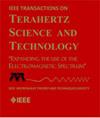A 16-GHz Bandwidth Cryogenic IF Amplifier With 4-K Noise Temperature for Sub-mm Radio-Astronomy Receivers
IF 3.9
2区 工程技术
Q2 ENGINEERING, ELECTRICAL & ELECTRONIC
IEEE Transactions on Terahertz Science and Technology
Pub Date : 2024-02-27
DOI:10.1109/TTHZ.2024.3370893
引用次数: 0
Abstract
The major mm and sub-mm radio-astronomy observatories are prioritizing instantaneous bandwidth widening for their current or planned upgrades this decade. We present an ultra-wideband and ultra-low-noise cryogenic hybrid amplifier with 4 K (用于亚毫米射电天文接收器的 16-GHz 带宽低温中频放大器,噪声温度为 4-K
主要的毫米和亚毫米射电天文台都在优先考虑瞬时带宽的拓宽,以便在本十年内进行或计划进行升级。我们展示了一款超宽带、超低噪声低温混合放大器,当冷却到 6 K 时,它在 2-18 GHz 频段的平均噪声温度为 4 K (NF = 0.06 dB)。该演示放大器可满足阿塔卡马大毫米/亚毫米波阵列(ALMA)下一代接收机对噪声和中频带宽的要求,将目前的最大中频瞬时带宽提高了一倍,并具有最先进的噪声性能,增益平坦度为 ±0.8 dB,在 85% 的频段内输出回损优于 15 dB。它可在 1-19 GHz 范围内使用,其性能降低可忽略不计,并与 602-720 GHz ALMA band-9 双边带 SIS 混频器一起进行了初步测试,结果表明,在 18 GHz 宽带内,中频噪声平均值平坦,波纹较低,接近直流。采用平衡配置来改善输入匹配是可行的。
本文章由计算机程序翻译,如有差异,请以英文原文为准。
求助全文
约1分钟内获得全文
求助全文
来源期刊

IEEE Transactions on Terahertz Science and Technology
ENGINEERING, ELECTRICAL & ELECTRONIC-OPTICS
CiteScore
7.10
自引率
9.40%
发文量
102
期刊介绍:
IEEE Transactions on Terahertz Science and Technology focuses on original research on Terahertz theory, techniques, and applications as they relate to components, devices, circuits, and systems involving the generation, transmission, and detection of Terahertz waves.
 求助内容:
求助内容: 应助结果提醒方式:
应助结果提醒方式:


